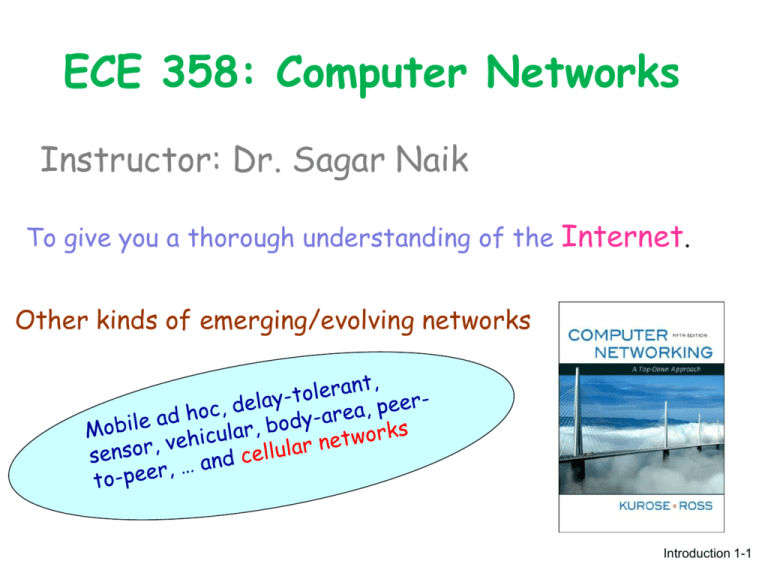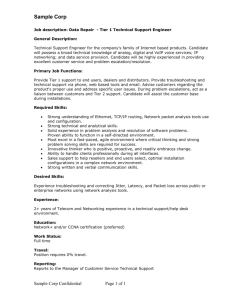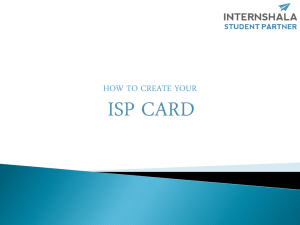
ECE 358: Computer Networks
Instructor: Dr. Sagar Naik
To give you a thorough understanding of the Internet.
Other kinds of emerging/evolving networks
Introduction 1-1
About the instructor
Teaching interest:
ECE 358, ECE 416, ECE 655
(Past: ECE 355, ECE 453)
Research:
Wireless networks: ad hoc, delay-tolerant, sensor,
vehicular, peer-to-peer
Smart grids
Energy efficiency of smartphones and tablets
Power efficiency of data centres
Introduction 1-2
Teaching Assistants
Greta Cutulenco:
Yasir Ali:
gcutulen@uwaterloo.ca, E5-4111
y5ali@uwaterloo.ca,
EIT-4122
Course website:
https://ece.uwaterloo.ca/~ece358/
Class email: ece_358@ecemail.uwaterloo.ca
Introduction 1-3
Grading scheme
Mini projects (3):
15% (5 + 5 + 5)
group size = 2
Midterm exam:
25%
Final exam:
60%
TBA
----------------------------------------------Total:
100%
Introduction 1-4
Some exam questions will be based on homeworks.
TAs will solve some of those questions in the tutorials.
Introduction
1-5
Three Objectives of ECE 358
Link
layer with
1-hop comm.
PC
server
layer (routing):
multi-hop comm.
Global ISP
Network
wireless
laptop
cellular
handheld
Home network
Transport
access
points
wired
links
router
medium access control:
Mobile network
layer:
end-to-end, reliable
comm. between apps.
Regional ISP
Institutional network
App
Transport (Ch. 3)
Network (Ch. 4)
Link/MAC (Ch. 5)
L1 Physical
L4
L3
L2 (Layer 2)
Teaching: Bottom-up approach
ISP: Internet Service ProviderIntroduction 1-6
LAN1
LAN: Local Area Network
A LAN is a network of computers
connected with a “broadcast” medium,
say, an L2 switch.
To other LANs on the
Internet
LAN2
Introduction
1-7
L2 and L3 switches and connectors
Mbps (Megabits/sec)
48 10/100/1000 BASE-T ports (RJ45)
Cisco L3 switch
(Catalyst 4948)
4 1000 BASE-X Small Formfactor Pluggable (SFP) optics ports
BASE: Baseband
Bits are not modulated.
T: Twisted pair (copper)
Back panel of Catalyst 4948
Dual power
supply
Removable
fans
Introduction
1-8
L2 and L3 switches and connectors
Cisco L2 switch
(SF300 24P)
24 10/100 BASE-T PoE (Power over Ethernet) ports
2 Gigabit ports
2 Fiber ports
Introduction
1-9
L2 and L3 switches and connectors
Common copper connectors …
Category 6 (Cat.6 on cables) cables support
Cat 5e
- 10
- 100
- 1000
- 10
BASE-T (Ethernet)
Cat 5
BASE-T (Fast Ethernet)
BASE-T (Giga Ethernet)
GBASE-T (10 Gigabit Ethernet)
Twisted to cancel out
electromagnet interference.
Introduction 1-10
L2 and L3 switches and connectors
Common fiber connectors …
GBIC: Gigabit Interface Converter (1 Gbps)
SFP: Small Form factor Pluggable trans. (1 Gbps)
SFP+: (10 Gbps)
CFP: C Form factor Pluggable (C in Latin = 100)
(100 Gbps)
Cisco CFP-100G-ER4
Introduction 1-11
Lectures, exams, reviews, and office hours
Basics of networking
Link layer (Medium access control+)
Midterm exam
Review
Past exams
Network layer (IP protocol)
Transport layer (Trans. Control Protocol)
Final exam
Past exams
Introduction 1-12
Handle:
@SagarNaik101
Hashtag:
#ECE358F14
Introduction 1-13
Classroom protocol
All cell phones, including mine, must be turned off.
•
Interference degrades performance.
•
No peer-to-peer communication
It causes interference.
Introduction 1-14
A note about the slides
All the slides were originally prepared by Kurose and Ross.
I have added more slides and edited most of the slides.
I will publish ALL slides, but may skip some so that you
continue to access the full set.
Introduction 1-15
Chapter 1
Introduction
A note on the use of these ppt slides:
We’re making these slides freely available to all (faculty, students, readers).
They’re in PowerPoint form so you can add, modify, and delete slides
(including this one) and slide content to suit your needs. They obviously
represent a lot of work on our part. In return for use, we only ask the
following:
If you use these slides (e.g., in a class) in substantially unaltered form, that
you mention their source (after all, we’d like people to use our book!)
If you post any slides in substantially unaltered form on a www site, that
you note that they are adapted from (or perhaps identical to) our slides, and
note our copyright of this material.
Computer Networking:
A Top Down Approach ,
5th edition.
Jim Kurose, Keith Ross
Addison-Wesley, April
2009.
Thanks and enjoy! JFK/KWR
All material copyright 1996-2010
J.F Kurose and K.W. Ross, All Rights Reserved
Introduction 1-16
Chapter 1: roadmap
1.1 What is the Internet?
1.2 Network edge
end systems, access networks, links
1.3 Network core: network of nets
circuit switching, packet switching, network structure
1.4 Delay, loss, and throughput in packet-switched
networks Performance metrics
1.5 Protocol layers, service models
Introduction 1-17
What’s the Internet: component view
DHCP
DHCP
DNS
DNS
Core
DNS
DHCP
server
DHCP DNS
Introduction 1-18
What’s the Internet: component view
millions
PC
server
wireless
laptop
cellular
handheld
router
of connected
computing devices:
Mobile network
Global ISP
running network apps
Home network
routers:
forward packets
(chunks of data)
Regional ISP
Institutional network
access
points communication links
wired
fiber, copper,
links
radio, satellite
Introduction 1-19
“Fun” internet appliances
Web-enabled toaster +
weather forecaster
IP picture frame
http://www.ceiva.com/
Internet
refrigerator
Internet phones
Introduction 1-20
What’s the Internet: component view
protocols control sending,
receiving of msgs
Mobile network
Global ISP
e.g., TCP, IP, HTTP, Ethernet
Internet: “network of nets”
loosely hierarchical
Internet standards
RFC: Request For Comments
IETF: Internet Eng. Task Force
Home network
Regional ISP
Institutional network
Introduction 1-21
What’s the Internet: a service view
communication infrastructure
enables distributed apps:
Web, VoIP, email, games, ecommerce, file sharing
Comm. services provided to apps:
reliable data delivery from
source to destination
“best effort” (unreliable)
data delivery
Introduction 1-22
What’s a protocol?
Protocols define
Format of messages (Message: Header + Optional data)
Order of messages sent and received among network entities
Actions taken on msg transmission and reception
All
comm. activities in Internet are governed by protocols.
Introduction 1-23
An Example
TCP connection
request
time
TCP connection
response
Get http://www.awl.com/kurose-ross
<file>
Introduction 1-24
Chapter 1: roadmap
1.1 What is the Internet?
1.2 Network edge
end systems, access networks, links
1.3 Network core
circuit switching, packet switching, network structure
1.4 Delay, loss and throughput in packet-switched
networks
1.5 Protocol layers, service models
1.6 Networks under attack: security
1.7 History
Introduction 1-25
The network edge:
end systems (hosts):
run application programs
e.g. Web, email
at “edge of network”
peer-peer
client/server model
client host requests, receives
service from always-on server
client/server
e.g. Web browser/server;
email client/server
peer-peer model:
minimal (or no) use of
dedicated servers
e.g. Skype, BitTorrent
Introduction 1-26
Access networks and physical media
Q: How to connect an end
system to an edge router?
residential access nets
DSL, Cable
institutional access networks
(school, company)
edge routers
Ethernet
mobile access networks
WiFi
Introduction 1-27
DSL: Digital Subscriber Line
Point-to-Point Protocol (PPP)
One home
Internet
home
phone
DSLAM:
DSL Access Multiplexer
DSLAM
splitter
home
PC
DSL
modem
:
:
telephone
network
central
office
To another home
uses existing telephone infrastructure
up to 1 Mbps upstream (today typically < 256 kbps)
up to 8 Mbps downstream (today typically < 1 Mbps)
Introduction 1-28
Cable Network Architecture: Overview
server(s)
cable headend
cable distribution
network
home
Introduction 1-29
Cable Network Architecture: Overview
cable headend
cable distribution
network (simplified)
home
Introduction 1-30
Cable Network Architecture: Overview
FDM (more shortly):
V
I
D
E
O
V
I
D
E
O
V
I
D
E
O
V
I
D
E
O
V
I
D
E
O
V
I
D
E
O
D
A
T
A
D
A
T
A
C
O
N
T
R
O
L
1
2
3
4
5
6
7
8
9
Channels
cable headend
cable distribution
network
home
Introduction 1-31
Ethernet Internet access
100 Mbps
Ethernet
switch
institutional
router
to institution’s
ISP
100 Mbps
1 Gbps
100 Mbps
Early Ethernet
server
typically used in companies, universities, etc
10 Mbps, 100Mbps, 1Gbps, 10Gbps Ethernet
Question: How do nodes efficiently share the medium?
Introduction 1-32
Wireless access networks
shared wireless access
network connects end system
to router
via base station aka “access
point”
wireless LANs:
router
base
station
802.11b/g (WiFi): 11 or 54 Mbps
wider-area wireless access
provided by telco operator
~1Mbps over cellular system
(EVDO, HSDPA)
LTE (Long Term Evolution)
mobile
hosts
Introduction 1-33
Home networks
Typical home network components:
DSL or cable modem
router/NAT (Network Address Translation)
Ethernet
wireless access point
to/from
cable
headend
cable
modem
wireless
laptops
router
Ethernet
wireless
access
point
Introduction 1-34
Chapter 1: roadmap
1.1 What is the Internet?
1.2 Network edge
end systems, access networks, links
1.3 Network core
circuit switching, packet switching, network structure
1.4 Delay, loss and throughput in packet-switched
networks
1.5 Protocol layers, service models
1.6 Networks under attack: security
1.7 History
Introduction 1-35
The Network Core
mesh of interconnected
routers
the fundamental question:
how is data transferred
through net?
circuit switching:
dedicated circuit per call:
telephone net
packet-switching: data
sent thru net in discrete
“chunks”
Introduction 1-36
Network Core: Circuit Switching
End-end resources are
reserved for “call”
link bandwidth, switch capacity
dedicated resources: no sharing
circuit-like (guaranteed)
performance
call setup required
Introduction 1-37
Network Core: Circuit Switching
Network resources
(e.g., bandwidth)
divided into “pieces”
dividing link bandwidth
into “pieces”
frequency division
time division
pieces allocated to calls
resource piece remains
idle if not used by
owning call
Introduction 1-38
Circuit Switching: FDM and TDM
Example:
FDM
4 users
frequency
time
TDM
frequency
time
Introduction 1-39
Numerical example (Fall 2012 Final Exam)
How long does it take to send a file of 640,000 bits
from host A to host B over a circuit-switched network?
Assume that:
•
•
•
•
all link speeds: 1.536 Mbps (Megabits per second)
each link uses TDM with 24 slots/sec
a user receives one slot every 8 slots in the TDM scheme
it takes 500 msec to establish an end-to-end circuit
Show the details of your calculations.
Introduction 1-40
Numerical example (Contd.: Answer)
The number of bits transmitted by a user in 1 slot = (1/24)* 1.536
Mbps = 64000 bits.
A user gets to transmit in 3 ( = 24/8) slots in each second.
So, the amount of data transmitted by a user in 1 second = 3 *
64000 bits.
To be able to transmit 640,000 bits, time needed =
640,000/(3*64,000) = 10/3 second. = 3.33 seconds.
You need 0.5 seconds to establish a connection.
Therefore, total time needed = 3.33 s + 0.5 s = 3.83 seconds
Introduction 1-41
Network Core: Packet Switching
each end-end data stream is
divided into packets
user A, B packets share
network resources
each packet uses full link
bandwidth
resources used as needed
Bandwidth division into “pieces”
Dedicated allocation
Resource reservation
resource contention:
aggregate resource
demand can exceed
amount available
congestion: packets
queue, wait for link use
store and forward:
packets move one hop at
a time
node receives complete
packet before forwarding
Introduction 1-42
Packet Switching: Statistical Multiplexing
100 Mb/s
Ethernet
A
B
statistical multiplexing
1.5 Mb/s
queue of packets
waiting for output link
D
C
E
sequence of A & B packets has no fixed timing pattern
bandwidth shared on demand: statistical multiplexing.
TDM: each host gets same slot in revolving TDM frame.
Introduction 1-43
Packet-switching: store-and-forward
L
R
R
takes L/R seconds to
transmit (push out)
packet of L bits on to
link at R bps
store and forward:
entire packet must
arrive at router before
it can be transmitted
on next link
delay = 3L/R (assuming
zero propagation delay)
R
Example:
L = 7.5 Mbits
(Note: packets are not that long!
~1.5KB is very common)
R = 1.5 Mbps
transmission delay = 15 sec
more on delay shortly …
Introduction 1-44
Packet-switching: store-and-forward
Introduction 1-45
Numerical example: Fall 2012 mid-term exam
A
Router 1
Link 1
R1
Router 2
Link 2
R2
B
Link 3
R3
Figure 1.
• Suppose that host A wants to send a 1 Gigabit file to host B.
• The network between A and B has three links (See Fig. 1.) of rates
R1 = 4Mbps, R2 = 2Mbps, and R3 = 1Mbps.
“Giga” means 109, “Mega” means 106, and “Kilo” means 103.
•If A sends the file as 1000-byte packets, how long does it take to move
the file from A to B? Show the details of your calculation.
•Assume that the propagation delays on the three links are zero seconds.
•Make other assumptions as necessary and appropriate.
Introduction 1-46
Numerical example: Fall 2012 mid-term exam
File size,
Packet size,
Packet count,
F = 1 Gigabit = 10^9 bits
P = 8 x 10^3 bits
N = F/P = 125 x 10^3
Ti = Time to transmit 1 packet over link i.
T1 = P/R1 = 8 x 10^3 bits / (4 x 10^6 bps) = 2 x 10^(-3) sec = 2 ms.
T2 = P/R2 = 8 x 10^3 bits / (2 x 10^6 bps) = 4 x 10^(-3) sec = 4 ms.
T3 = P/R3 = 8 x 10^3 bits / (1 x 10^6 bps) = 8 x 10^(-3) sec = 8 ms.
Host A will take N x T1
Router 1 will take N x T2
Router 2 will take N x T3
= 125 x 10^3 x 2 x 10^(-3) sec = 250 sec
= 125 x 10^3 x 4 x 10^(-3) sec = 500 sec
= 125 x 10^3 x 8 x 10^(-3) sec = 1000 sec
File transfer time (exact solution: see next page) = 1000.006 s.
Approximate solution
Bottleneck link is link 3 so the throughput of the network between A and B is R3.
Therefore, file transfer time = F / R3
= 1 x 10^9 bits/ 1 x 10^6 bps
= 1 x 10^3 sec
= 1000 sec.
Introduction 1-47
Numerical example: Fall 2012 mid-term exam
1000.006 s
Introduction 1-48
Packet switching versus circuit switching
Packet switching allows more users to use network!
Example:
1 Mb/s link
each user:
• 100 kb/s when “active”
• active 10% of time
N
users
1 Mbps link
circuit-switching:
10 users
packet
switching:
with 35 users, probability
> 10 active at same time
is less than .0004
Introduction 1-49
Packet switching versus circuit switching
great for bursty data: you can support more users
resource sharing
simpler, no call setup
excessive congestion: packet delay and loss
protocols needed for reliable data transfer,
congestion control
Q: How to provide circuit-like behavior?
bandwidth guarantees needed for audio/video apps
still an unsolved problem (chapter 7)
Introduction 1-50
Fall 2012 final exam question (6/60 marks)
Compare circuit switching with packet switching by identifying five
attributes of communication systems. For full credit, state the most
important attributes.
Attributes
Circuit switching
Packet switching
Introduction 1-51
Fall 2012 final exam question (6/60 marks)
Attributes
Circuit switching
Packet switching
Conn. Estm.
Yes
No
Resource Res
Yes
No
Multiplexing
Time Division Multiplexing
Statistical Multiplexing
Frequency Division Multiplexing
Performance
Guarantee
Yes
Number
users
Resource
utilization
of Upper bounded, for a given
multiplexing scheme
Slots can go unused if users
do not have traffic
No
Not bounded
A smaller number of users means
that they get more share of the
bandwidth
Introduction 1-52
Internet structure: network of networks
roughly hierarchical
at center: small # of well-connected large networks
“tier-1” commercial ISPs (e.g., Verizon, Sprint, AT&T, Qwest,
Level3), national & international coverage
large content distributors (Google, Akamai (Netflix: Open Connect),
Microsoft)
treat each other as equals (no charges)
Tier-1 ISPs &
Content
Distributors,
interconnect
(peer) privately
IXP
Large Content
Distributor
(e.g., Akamai)
… or at Internet Exchange
Points (IXPs)
Canadian Tier-1: MTS Allstream
(MTS: Manitoba Telco Service)
IXP
Tier 1 ISP
Tier 1 ISP
Large Content
Distributor
(e.g., Google)
Tier 1 ISP
Introduction 1-53
Tier-1 ISP: e.g., Sprint
POP: point-of-presence
to/from backbone
peering
…
.
…
…
…
…
to/from customers
Introduction 1-54
Internet structure: network of networks
“tier-2” ISPs: smaller (often regional) ISPs
connect to one or more tier-1 (provider) ISPs
each tier-1 has many tier-2 customer nets
tier 2 pays tier 1 provider
tier-2
nets sometimes peer directly with each other
(bypassing tier 1) , or at IXP
IXP
Large Content
Distributor
(e.g., Akamai)
Tier 2
Tier 2 ISP Tier 2
ISP
ISP
IXP
Tier 1 ISP
Tier 2
Tier 1 ISP
ISP Tier 2
Tier 2
ISP
ISP
Large Content
Distributor
(e.g., Google)
Tier 1 ISP
Tier 2
ISP
Tier 2
ISP
Tier 2
ISP
Introduction 1-55
Internet structure: network of networks
“Tier-3” ISPs, local ISPs
customer of tier 1 or tier 2 network
last hop (“access”) network (closest to end systems)
IXP
Large Content
Distributor
(e.g., Akamai)
Tier 2
Tier 2 ISP Tier 2
ISP
ISP
IXP
Tier 1 ISP
Tier 2
Tier 1 ISP
ISP Tier 2
Tier 2
ISP
ISP
Large Content
Distributor
(e.g., Google)
Tier 1 ISP
Tier 2
ISP
Tier 2
ISP
Tier 2
ISP
Introduction 1-56
Internet structure: network of networks
a packet passes through many networks from source
host to destination host
In near future…end-end data
transfer is likely to be like this:
First segment: statistical multiplexing..
Middle segment: Light path (i.e. circuit with WDM)
Final segment: statistical multiplexing..
IXP
Large Content
Distributor
(e.g., Akamai)
Tier 2
Tier 2 ISP Tier 2
ISP
ISP
IXP
Tier 1 ISP
Tier 2
Tier 1 ISP
ISP Tier 2
Tier 2
ISP
ISP
Large Content
Distributor
(e.g., Google)
Tier 1 ISP
Tier 2
ISP
Tier 2
ISP
Tier 2
ISP
Introduction 1-57
Chapter 1: roadmap
1.1 What is the Internet?
1.2 Network edge
end systems, access networks, links
1.3 Network core
circuit switching, packet switching, network structure
1.4 Delay, loss and throughput in packet-switched
networks
1.5 Protocol layers, service models
1.6 Networks under attack: security
1.7 History
Introduction 1-58
How do loss and delay occur?
packets queue in router buffers (i.e. memory)
packet arrival rate to link exceeds output link capacity
packets queue, wait for turn
packet being transmitted (delay)
A
1.5 Mbps
B
Corrupted packets
are dropped.
packets queueing (delay)
free (available) buffers: arriving packets
dropped (loss) if no free buffers
Introduction 1-59
Four sources of packet delay
transmission
A
propagation
B
nodal
processing
queueing
dnodal = dproc + dqueue + dtrans + dprop
dproc: nodal processing
check bit errors
determine output link
typically < msec
dqueue: queueing delay
time waiting at output link
for transmission
depends on congestion level
of router
Introduction 1-60
Four sources of packet delay
transmission
A
propagation
B
nodal
processing
queueing
dnodal = dproc + dqueue + dtrans + dprop
dtrans: transmission delay:
L: packet length (bits)
R: link bandwidth (bps)
dtrans = L/R
dtrans and dprop
very different
dprop: propagation delay:
d: length of physical link
s: propagation speed in
medium (~2x108 m/sec)
dprop = d/s
Introduction 1-61
R: link bandwidth (bps)
L: packet length (bits)
a: average packet arrival
rate (#packets/s)
average queueing
delay
Queueing delay (revisited)
traffic intensity
= La/R
La/R ~ 0: avg. queueing delay small
La/R -> 1: avg. queueing delay large
La/R > 1: more “work” arriving
than can be serviced, average delay infinite!
La/R ~ 0
La/R -> 1
Introduction 1-62
“Real” Internet delays
What do real Internet delay look like?
Traceroute program: provides delay measurement
from source to router along end-end Internet path
towards destination.
For all i: (ith router)
sends three packets that will reach router i on path
towards destination
router i will return packets to sender
sender times interval between transmission and reply.
3 probes
3 probes
3 probes
C:xyz>tracert u-aizu.ac.jp
Introduction 1-63
“Real” Internet delays and routes
traceroute: gaia.cs.umass.edu to www.eurecom.fr
Three delay measurements from
gaia.cs.umass.edu to cs-gw.cs.umass.edu
1 cs-gw (128.119.240.254) 1 ms 1 ms 2 ms
2 border1-rt-fa5-1-0.gw.umass.edu (128.119.3.145) 1 ms 1 ms 2 ms
3 cht-vbns.gw.umass.edu (128.119.3.130) 6 ms 5 ms 5 ms
4 jn1-at1-0-0-19.wor.vbns.net (204.147.132.129) 16 ms 11 ms 13 ms
5 jn1-so7-0-0-0.wae.vbns.net (204.147.136.136) 21 ms 18 ms 18 ms
6 abilene-vbns.abilene.ucaid.edu (198.32.11.9) 22 ms 18 ms 22 ms
7 nycm-wash.abilene.ucaid.edu (198.32.8.46) 22 ms 22 ms 22 ms trans-oceanic
8 62.40.103.253 (62.40.103.253) 104 ms 109 ms 106 ms
link
9 de2-1.de1.de.geant.net (62.40.96.129) 109 ms 102 ms 104 ms
10 de.fr1.fr.geant.net (62.40.96.50) 113 ms 121 ms 114 ms
11 renater-gw.fr1.fr.geant.net (62.40.103.54) 112 ms 114 ms 112 ms
12 nio-n2.cssi.renater.fr (193.51.206.13) 111 ms 114 ms 116 ms
13 nice.cssi.renater.fr (195.220.98.102) 123 ms 125 ms 124 ms
14 r3t2-nice.cssi.renater.fr (195.220.98.110) 126 ms 126 ms 124 ms
15 eurecom-valbonne.r3t2.ft.net (193.48.50.54) 135 ms 128 ms 133 ms
16 194.214.211.25 (194.214.211.25) 126 ms 128 ms 126 ms
17 * * *
* means no response (probe lost, router not replying)
18 * * *
19 fantasia.eurecom.fr (193.55.113.142) 132 ms 128 ms 136 ms
Introduction 1-64
Packet loss
queue (i.e. buffer) preceding link has finite
capacity
packet arriving to full queue dropped (aka lost)
lost packet may be retransmitted by previous
node, by source end system, or not at all
buffer
(waiting area)
A
B
packet being transmitted
packet arriving to
full buffer is lost
Introduction 1-65
Throughput
(the output rate of an input/output system)
throughput: rate (bits/time unit) at which bits
transferred between sender/receiver
instantaneous: rate at given point in time (=max rate)
average: rate over longer period of time
link
capacity
that
can carry
server,
with
server
sends
bits pipe
Rs bits/sec
fluid
at rate
file of
F bits
(fluid)
into
pipe
Rs bits/sec)
to send to client
link that
capacity
pipe
can carry
Rfluid
c bits/sec
at rate
Rc bits/sec)
Introduction 1-66
Throughput (more)
Rs < Rc What is average end-end throughput?
Rs bits/sec
Rc bits/sec
Rs > Rc What is average end-end throughput?
Rs bits/sec
Rc bits/sec
bottleneck link
link on end-end path that constrains end-end throughput
Introduction 1-67
Throughput: Internet scenario
per-connection
end-end
throughput:
min(Rc,Rs,R/10)
in practice: Rc or
Rs is often
bottleneck
Rs
Rs
Rs
R
Rc
Rc
Rc
10 connections (fairly) share
backbone bottleneck link R bits/sec
Introduction 1-68
Chapter 1: roadmap
1.1 What is the Internet?
1.2 Network edge
end systems, access networks, links
1.3 Network core
circuit switching, packet switching, network structure
1.4 Delay, loss and throughput in packet-switched
networks
1.5 Protocol layers, service models
1.6 Networks under attack: security
1.7 History
Introduction 1-69
Protocol “Layers”
Networks are complex,
with many “pieces”:
hosts
routers
links of various media
applications
protocols
hardware, software
App
Transport (Ch. 3)
Network (Ch. 4)
Link/MAC (Ch. 5)
Physical
Introduction 1-70
Why layering?
Very different functionalities are addressed in
different layers.
Ex.: medium access is very different from routing
Modularization eases maintenance and system evolution
Ex.: change in network interface does not require
TCP to be modified.
App
Transport (Ch. 3)
Network (Ch. 4)
Link/MAC (Ch. 5)
Physical
Introduction 1-71
Internet protocol stack (on end devices)
application: supporting network
applications
FTP, SMTP, HTTP
transport: process-process data
transfer
TCP, UDP
network: routing of datagrams from
source to destination
IP, routing protocols
link: data transfer between
neighboring network elements
(MAC/Link)
physical: bits “on the wire”:
Ethernet, 802.11 (WiFi)
App
Transport
Network
Link
Physical
Introduction 1-72
ISO/OSI reference model
International Standards Organization/ Open System Interconnection
presentation: allow applications to
interpret meaning of data, e.g.,
application
encryption, compression, machinepresentation
specific conventions
session
session: synchronization,
checkpointing, recovery of data
transport
exchange
network
Internet stack “missing” these
link
layers!
physical
these services, if needed, must
be implemented in application
needed?
Introduction 1-73
source
message
segment Ht
datagram Hn Ht
frame Hl Hn Ht
M
M
M
M
application
transport
network
link
physical
Encapsulation using headers
link
physical
switch
destination
M
Ht
M
Hn Ht
Hl Hn Ht
M
M
application
transport
network
link
physical
Hn Ht
Hl Hn Ht
M
M
network
link
physical
Hn Ht
M
router
Introduction 1-74
Internet History
1961-1972: Early packet-switching principles
1961: Kleinrock - queueing
theory shows
effectiveness of packetswitching
1964: Baran - packetswitching in military nets
1967: ARPAnet conceived
by Advanced Research
Projects Agency
1969: first ARPAnet node
operational
1972:
ARPAnet public demonstration
NCP (Network Control Protocol)
first host-host protocol
first e-mail program
ARPAnet has 15 nodes
Introduction 1-75
Internet History
1972-1980: Internetworking, new and proprietary nets
1970: ALOHAnet satellite
network in Hawaii
1974: Cerf and Kahn architecture for
interconnecting networks
1976: Ethernet at Xerox
PARC
late70’s: proprietary
architectures: DECnet, SNA
late 70’s: switching fixed
length packets (ATM
precursor)
1979: ARPAnet has 200 nodes
Cerf and Kahn’s
internetworking principles:
minimalism, autonomy no internal changes
required to
interconnect networks
best effort service
model
stateless routers
decentralized control
define today’s Internet
architecture
Introduction 1-76
Internet History
1980-1990: new protocols, a proliferation of networks
1983: deployment of
TCP/IP
1982: smtp e-mail
protocol defined
1983: DNS defined
for name-to-IPaddress translation
1985: ftp protocol
defined
1988: TCP congestion
control
new national networks:
Csnet, BITnet,
NSFnet, Minitel
100,000 hosts
connected to
confederation of
networks
Introduction 1-77
Internet History
1990, 2000’s: commercialization, the Web, new apps
early
1990’s: ARPAnet
decommissioned
1991: NSF lifts restrictions on
commercial use of NSFnet
(decommissioned, 1995)
early 1990s: Web
hypertext [Bush 1945, Nelson
1960’s]
HTML, HTTP: Berners-Lee
1994: Mosaic, later Netscape
late 1990’s: commercialization
late 1990’s – 2000’s:
more killer apps: instant
messaging, P2P file sharing
network security to
forefront
est. 50 million host, 100
million+ users
backbone links running at
Gbps
of the Web
Introduction 1-78
Internet History
2010:
~750 million hosts
voice, video over IP
P2P applications: BitTorrent
(file sharing) Skype (VoIP),
PPLive (video)
more applications: YouTube,
gaming, Twitter
wireless, mobility
Introduction 1-79
Next…..
1-hop communication
Multi-hop communication
End-to-end reliable comm.
with TCP
Introduction 1-80






